Application of Affordance Factors for User-Centered Smart Homes: A Case Study Approach
Abstract
1. Introduction
2. Smart Homes
2.1. Smart Home Services
2.2. Interaction between Users and Smart Home Components
3. Affordances
3.1. Concept of Affordance
3.2. Affordances in a Smart Home
4. Case Study
4.1. Research Methodology
4.2. Overview of the Cases
4.3. Case Analysis Results
4.3.1. S Exhibition Hall
4.3.2. P model House
4.3.3. L Model House
4.3.4. H Model House
5. Discussion
5.1. Cognitive Affordances
- Apply a simple design consisting of buttons and displays of main functions;
- Hide infrequently used functions;
- Organize menus hierarchically;
- Group related contents together;
- Use familiar and concise button names without abbreviations or jargon;
- Provide key information concisely using familiar terms;
- Provide information that matches the menu names;
- Use button names that enable prediction of the function;
- Use button names that enable clear recognition of the operation target;
- Use universal icons with text labels on buttons.
5.2. Physical Affordances
- Apply a multimodal interface to vary the input and output methods;
- Allow control of the device with a few simple actions;
- Apply easy-to-learn and easy-to-remember device operating methods;
- Keep the interface consistent so that the same interactions lead to the same results;
- Provide the same menu item in the same location on every screen of the wall pad;
- Install the control devices in each room to enable environmental control and monitoring;
- Install the control devices at a height that is convenient for operation (e.g., it is recommended to install the wall pads approximately 1400 mm from the floor, the switches 750–1200 mm from the floor, and the bathroom speakerphone approximately 800 mm from the floor);
- In the touch interface, touch targets should be at least 10 mm by 10 mm in size, with 2 mm gap between targets to prevent mis-taps;
- Provide a ‘Home’ button on the wall pad to reduce work steps;
- Provide an ‘All Off’ function to control the indoor environment with one touch.
5.3. Functional Affordances
- Increase accessibility by providing shortcut buttons for frequently used or emergency functions;
- Allow users to set customized modes and easily control the indoor environment for each mode;
- Allow users to customize the interface for their preference (e.g., screen brightness, volume, font, and font size adjustment);
- Allow users to store and easily implement their preferred indoor environmental conditions;
- For energy management functions, enable customized energy management by self-monitoring, setting goals, and comparing usage with neighbors;
- Provide feedback that clearly indicates the results of actions for every manipulation;
- Provide visual feedback that clearly indicates the selected function;
- Provide informative feedback that provides information on how to resolve an error;
- For safety-related functions and functions that take time to complete, provide multiple types of feedback (e.g., visual, auditory, and tactile feedback) to ensure that the feedback is clearly recognized;
- Provide ‘Back’ and ‘Cancel’ functions to easily reverse actions;
- Provide help where it is easily accessible.
5.4. Sensory Affordances
- Avoid using decorative fonts;
- Do not use more than three fonts on one screen;
- The brightness contrast between the text and the background should be at least 4.5:1;
- If text can be magnified, the contrast between the text and the background should be at least 3:1;
- Apply a color with high visibility to text that notifies of caution, error, or danger;
- Do not use more than four colors on one screen;
- The buttons for emergency functions (e.g., emergency call) should be distinguished from other buttons by color to be noticeable;
- Differentiate size, color, and thickness of the font according to the hierarchy of information;
- Place frequently checked information or important function in a prominent position,
6. Conclusions
Author Contributions
Funding
Conflicts of Interest
Appendix A
| Category | Guidelines |
|---|---|
| Cognitive Affordances |
|
| Physical Affordances |
|
| Functional Affordances |
|
| Sensory Affordances |
|
References
- Rebecca, F.; Marco, P.; Angela, S.; Beth, K. Categories and functionality of smart home technology for energy management. Build. Environ. 2017, 123, 543–554. [Google Scholar]
- Nicholas, G.; Eduardo, A.M.C.; Pierluigi, M. Ten questions concerning smart districts. Build. Environ. 2017, 118, 362–376. [Google Scholar]
- Demiris, G.; Hensel, B. Technologies for an aging society: A systematic review of ‘smart home’ applications. Yearb. Med. Inform. 2008, 17, 33–40. [Google Scholar]
- Cook, D.J.; Augusto, J.C.; Jakkula, V.R. Ambient intelligence: Technologies, application, and opportunity. Pervasive Mob. Comput. 2009, 5, 277–298. [Google Scholar] [CrossRef]
- Sadiku, M.N.O.; Musa, S.M.; Nelatury, S.R. Smart homes. J. Sci. Eng. Res. 2016, 3, 465–467. [Google Scholar]
- Hargreaves, T.; Wilson, C.; Hauxwell-Baldwin, R. Learning to live in a smart home. Build. Res. Inf. 2018, 46, 127–139. [Google Scholar] [CrossRef]
- Haines, V.; Maguire, M.; Cooper, C.; Mitchell, V.; Lenton, F.; Keval, H.; Nicolle, C. User Centred Design in Smart Homes: Research to Support the Equipment and Services Aggregation Trials; Loughborough University Institutional Repository: Loughborough, UK, 2005. [Google Scholar]
- Makonin, S.; Bartram, L.; Popowich, F. A smarter smart home: Case studies of ambient intelligence. IEEE Pervas. Comput. 2012, 12, 58–66. [Google Scholar] [CrossRef]
- Lee, S.W.; Mase, K. Activity and location recognition using wearable sensors. IEEE Pervasive Comput. 2002, 1, 24–32. [Google Scholar]
- Tapia, E.M.; Intille, S.S.; Larson, K. Activity recognition in the home using simple and ubiquitous sensors. In Proceedings of the 2004 2nd International Conference on Pervasive Computing (Pervasive), Linz/Vienna, Austria, 21–23 April 2004; pp. 158–175. [Google Scholar]
- Uddin, M.Z.; Kim, T.S.; Kim, J.T. Video-based indoor human gait recognition using depth imaging and hidden Markov model: A smart system for smart home. Indoor Built Environ. 2011, 20, 120–128. [Google Scholar] [CrossRef]
- Kim, S.C.; Jeong, Y.S.; Park, S.O. RFID-based indoor location tracking to ensure the safety of the elderly in smart home environments. Pers. Ubiquit. Comput. 2013, 17, 1699–1707. [Google Scholar] [CrossRef]
- Niccolò, M.; Guido, M.; Paolo, C. Cloud-based behavioral monitoring in smart homes. Sensors 2018, 18, 1951. [Google Scholar]
- Yanni, Z.; Xiaodong, C. Design of smart home remote monitoring system based on embedded system. In Proceedings of the 2011 IEEE 2nd International Conference on Computing, Control and Industrial Engineering (CCIE), Wuhan, China, 20–21 August 2011; pp. 41–44. [Google Scholar]
- Han, Y.S.; Hyun, J.H.; Jeong, T.Y.; Yoo, J.H.; James Hong, W.K. A smart home control system based on context and human speech. In Proceedings of the 2016 18th International Conference on Advanced Communication Technology (ICACT), Pyeongchang, Korea, 31 January–3 February 2016; pp. 165–169. [Google Scholar]
- Alexis, B.; François, P.; Michel, V. Arcades: A deep model for adaptive decision making in voice controlled smart-home. Pervasive Mob. Comput. 2018, 49, 92–110. [Google Scholar]
- Park, G.W.; Kim, H.S. Low-cost implementation of a named entity recognition system for voice-activated human-appliance interfaces in a smart home. Sustainability 2018, 10, 488. [Google Scholar] [CrossRef]
- Meng, Z.; Lu, J. A Rule-based service customization strategy for smart home context-aware automation. IEEE Trans. Mob. Comput. 2016, 15, 558–571. [Google Scholar] [CrossRef]
- Byun, J.S.; Park, S.U.; Cho, K.H.; Park, S.H. Zone-aware service platform: A new concept of context-aware networking and communications for smart-home sustainability. Sustainability 2018, 10, 266. [Google Scholar] [CrossRef]
- Liang, T.; Zeng, B.; Liu, J.; Ye, L.; Zou, C. An unsupervised user behavior prediction algorithm based on machine learning and neural network for smart home. IEEE Access 2018, 6, 49237–49247. [Google Scholar] [CrossRef]
- Weixian, L.; Logenthiran, T.; Van-Tung, P.; Woo, W.L. Implemented IoT-based self-learning home management system (SHMS) for Singapore. IEEE Internet Things J. 2018, 5, 2212–2219. [Google Scholar]
- De Silva, L.C.; Dewana, T.; Petra, M.I.; Punchihewa, G.A. Multiple sensor based autonomous monitoring and control for energy efficiency. In Proceedings of the 2010 FIRA RoboWorld Congress: Trends in Intelligent Robotics, Bangalore, India, 15–17 September 2010; pp. 361–368. [Google Scholar]
- Han, D.M.; Lim, J.H. Design and implementation of smart home energy management systems based on ZigBee. IEEE T. Consum. Electr. 2010, 56, 1417–1425. [Google Scholar] [CrossRef]
- Pedrasa, M.A.A.; Spooner, T.D.; MacGill, I.F. Coordinated scheduling of residential distributed energy resources to optimize smart home energy services. IEEE T. Smart Grid. 2010, 1, 134–143. [Google Scholar] [CrossRef]
- Al-Ali, A.R.; Zualkernan, I.A.; Rashid, M.; Gupta, R.; Alikarar, M. A smart home energy management system using IoT and big data analytics approach. IEEE T. Consum. Electr. 2017, 63, 426–434. [Google Scholar] [CrossRef]
- Jo, H.N.; Yoon, Y.I. Intelligent smart home energy efficiency model using artificial TensorFlow engine. Hum. Cent. Comput. Inf. Sci. 2018, 8, 1–18. [Google Scholar] [CrossRef]
- Virone, G.; Noury, N.; Demongeot, J. A system for automatic measurement of circadian activity deviations in telemedicine. IEEE Trans. Biomed. Eng. 2002, 49, 1463–1469. [Google Scholar] [CrossRef] [PubMed]
- Deen, M.J. Information and communications technologies for elderly ubiquitous healthcare in a smart home. Pers. Ubiquit. Comput. 2015, 19, 573–599. [Google Scholar] [CrossRef]
- Leandro, Y.M.; Bruno, S.F.; Luis, H.V.N.; Pedro, H.G.; Giampaolo, L.L.; Rodolfo, I.M.; Geraldo, P.R.F.; Giancristofaro, G.T.; Gustavo, P.; Bhaskar, K.; et al. Exploiting IoT technologies for enhancing health smart homes through patient identification and emotion recognition. Comput. Commun. 2016, 89–90, 178–190. [Google Scholar]
- Muhammad, G.; Rahman, S.K.M.; Alelaiwi, A.; Alamri, A. Smart health solution integrating IoT and cloud: A case study of voice pathology monitoring. IEEE Commun. Mag. 2017, 55, 69–73. [Google Scholar] [CrossRef]
- Pham, M.; Mengistu, Y.; Do, H.; Sheng, W. Delivering home healthcare through a cloud-based smart home environment (CoSHE). Future Gener. Comput. Syst. 2018, 81, 129–140. [Google Scholar] [CrossRef]
- Mennicken, S.; Vermeulen, J.; Elaine, M. From today’s augmented houses to tomorrow’s smart homes: New directions for home automation research. In Proceedings of the 2014 ACM International Joint Conference on Pervasive and Ubiquitous Computing (UbiComp), Seattle, WA, USA, 13–17 September 2014; pp. 105–115. [Google Scholar]
- Gibson, J.J. The Ecological Approach to Visual Perception; Houghton Mifflin: Boston, MA, USA, 1979. [Google Scholar]
- Gaver, W.W. Technology affordances. In Proceeding of the 1991 Conference on Human Factors in Computing Systems (CHI), New Orleans, LA, USA, 27 April–02 May 1991; pp. 79–84. [Google Scholar]
- Norman, D.A. Affordance, conventions, and design. Interactions 1999, 6, 38–42. [Google Scholar] [CrossRef]
- McGrenere, J.; Ho, W. Affordances: Clarifying and evolving a concept. In Proceedings of the 2000 Graphics Interface, Montréal, QC, Canada, 15–17 May 2000; pp. 179–186. [Google Scholar]
- Hartson, H.R. Cognitive, physical, sensory and functional affordances in interaction design. Behav. Inform. Technol. 2003, 22, 315–338. [Google Scholar] [CrossRef]
- Koskela, T.; Väänänen-Vainio-Mattila, K. Evolution towards smart home environments: Empirical evaluation of three user interfaces. Pers. Ubiquit. Comput. 2004, 8, 234–240. [Google Scholar] [CrossRef]
- Portet, F.; Vacher, M.; Golanski, C.; Roux, C.; Meillon, B. Design and evaluation of a smart home voice interface for the elderly: Acceptability and objection aspects. Pers. Ubiquit. Comput. 2013, 17, 127–144. [Google Scholar] [CrossRef]
- Yang, H.; Dominique, T.; Taylor, A.; Aaron, S.C.; Diane, J.C.; Maureen, S.-E. Smart home in a box: Usability study for a large scale self-installation of smart home technologies. J. Reliable Intell. Environ. 2016, 2, 93–106. [Google Scholar]
- Balta-Ozkan, N.; Davidson, R.; Bicket, M.; Whitmarsh, L. Social barriers to the adoption of smart homes. Energy Policy 2013, 63, 363–374. [Google Scholar] [CrossRef]
- Lee, H.; Park, S.J.; Kim, M.J.; Jung, J.Y.; Lim, H.W.; Kim, J.T. The service pattern-oriented smart bedroom based on elderly spatial behaviour patterns. Indoor Built Environ. 2013, 22, 299–308. [Google Scholar] [CrossRef]
- Marikyan, D.; Papagiannidis, S.; Alamanos, E. A systematic review of the smart home literature: A user perspective. Technol. Forecast. Soc. Change. 2019, 138, 139–154. [Google Scholar] [CrossRef]
- Aldrich, F.K. Smart homes: Past, present and future. In Inside the Smart Home; Harper, R., Ed.; Springer: London, UK, 2003; pp. 17–39. [Google Scholar]
- Lee, H.; Park, S.J.; Lim, H.W.; Kim, J.T. Scenario-based smart services for single-person households. Indoor Built Environ. 2013, 22, 309–318. [Google Scholar] [CrossRef]
- Kim, H.S.; Kim, H.C.; Ji, Y.G. User Requirement elicitation for U-city residential environment: Concentrated on smart home service. J. Soc. e-Bus. Stud. 2015, 20, 167–182. [Google Scholar] [CrossRef]
- Arriany, A.A.; Musbah, M.S. Applying voice recognition technology for smart home networks. In Proceedings of the 2016 International Conference on Engineering & MIS (ICEMIS), Agadir, Morocco, 22–24 September 2016; pp. 1–6. [Google Scholar]
- Dewsbury, G.; Taylor, B.; Edge, M. The process of designing appropriate smart homes: Including the user in the design. In Proceedings of the 1st Equator IRC Workshop on Ubiquitous Computing in Domestic Environments, The School of Computer Science and Information Technology, The School of Computer Science and Information Technology, The University of Nottingham, Nottingham, UK, 13–14 September 2001; pp. 131–146. [Google Scholar]
- Motlagh, N.H.; Khajavi, S.H.; Jaribion, A.; Jan Holmström, J. An IoT-based automation system for older homes: A use case for lighting system. In Proceedings of the 2018 IEEE 11th International Conference on Service-Oriented Computing and Applications (SOCA), Paris, France, 20–22 November 2018; pp. 247–252. [Google Scholar]
- Kaila, L. Technologies Enabling Smart Homes. Ph.D. Thesis, Tampere University of Technology, Tampere, Finland, 2009. [Google Scholar]
- Norman, D.A. The Psychology of Everyday Things; Basic Books: New York, NY, USA, 1988. [Google Scholar]
- Nielsen, J. 10 Usability heuristics for user interface design. Nielsen Norman Group, 24 April 1994. Available online: https://www.nngroup.com/articles/ten-usability-heuristics/ (accessed on 26 February 2019).
- Mandel, T. The Elements of User Interface Design; John Wiley & Sons, Inc.: Hoboken, NJ, USA, 1997. [Google Scholar]
- Adream, B.E.; Mike, Z. User interface design principles for interaction design. Des. Issues 2008, 24, 85–107. [Google Scholar]
- Edwards, W.K.; Grinter, R.E. At home with ubiquitous computing: Seven challenges. In Proceedings of the 2001 International Conference on Ubiquitous Computing (Ubicomp), Atlanta, GA, USA, 30 September–2 October 2001. [Google Scholar]
- Chi, C.-F.; Dewi, R.S.; Samali, P.; Hsieh, D.-Y. Preference ranking test for different icon design formats for smart living room and bathroom functions. Appl. Ergon. 2019, 81, 102891. [Google Scholar] [CrossRef] [PubMed]
- Hannah, A. Making your icons user-friendly: A guide to usability in UI design. UserTesting, 4 August 2015. Available online: https://www.usertesting.com/blog/user-friendly-ui-icons/ (accessed on 28 December 2019).
- Yang, J. Multilayer adaptation based complex echo cancellation and voice enhancement. In Proceedings of the 2018 IEEE International Conference on Acoustics, Speech and Signal Processing (ICASSP), Calgary, AB, Canada, 15–20 April 2018; pp. 2131–2135. [Google Scholar]
- Lee, K.M.; Teng, W.-G. Point-n-Press: An intelligent universal remote control system for home appliances. IEEE T. Autom. Sci. Eng. 2016, 13, 1308–1317. [Google Scholar] [CrossRef]
- Pu, Q.; Gupta, S.; Gollakota, S.; Patel, S. Whole-home gesture recognition using wireless signals. In Proceedings of the 2013 19th Annual International Conference on Mobile Computing & Networking (MobiCom), Miami, FL, USA, 30 September–04 October 2013; pp. 27–38. [Google Scholar]
- Cho, M.E.; Kim, M.J. Users’ preference and acceptance of smart home technologies. JAIK 2018, 34, 75–84. [Google Scholar]
- Housing and Urban Research Institute. A Study on the Development of Home Network Housing for the Underprivileged; Ministry of Land, Transport and Maritime Affairs: Seoul, Korea, 2008. [Google Scholar]
- Centre for Excellence in Universal Design. Universal Design Guidelines for Homes in Ireland; Centre for Excellence in Universal Design: Dublin, Ireland, 2013; Available online: http://universaldesign.ie/News-events/News/Universal-Design-Guidelines-for-Homes-in-Ireland.pdf (accessed on 29 July 2019).
- Budiu, R.; Nielsen, J. Usability of iPad Apps and Websites, 2nd ed.; Nielsen Norman Group: Fremont, CA, USA, 2011. [Google Scholar]
- Grant, W. 101 UX Principles: A Definitive Design Guide; Packt Publishing Ltd.: Birmingham, UK, 2018. [Google Scholar]
- Harley, A. Touch targets on touchscreens. Nielsen Norman Group, 5 May 2019. Available online: https://www.nngroup.com/articles/touch-target-size/ (accessed on 29 July 2019).
- Yun, R.; Scupelli, P.; Aziz, A.; Loftness, V. Sustainability in the workplace: Nine intervention techniques for behavior change. In Proceedings of the 2013 8th International Conference on Persuasive, Sydney, Australia, 3–5 April 2013; pp. 253–265. [Google Scholar]
- W3C. Available online: http://www.w3.org/TR/UNDERSTANDING-WCAG20/visual-audio-contrast-contrast.html (accessed on 29 July 2019).
- Apple Human Interface Guidelines. Available online: https://developer.apple.com/design/human-interface-guidelines/accessibility/overview/color-and-contrast/ (accessed on 28 December 2019).
- Choi, M.K. A study on the apt bill redesign for contributing to the change of energy saving behavior. J. Korean Soc. Des. Cult. 2011, 17, 583–598. [Google Scholar]
- Moon, J.H. A fundamental study on application methods of the service design for electrical energy saving. J. Korean Soc. Des. Cult. 2015, 21, 215–223. [Google Scholar]
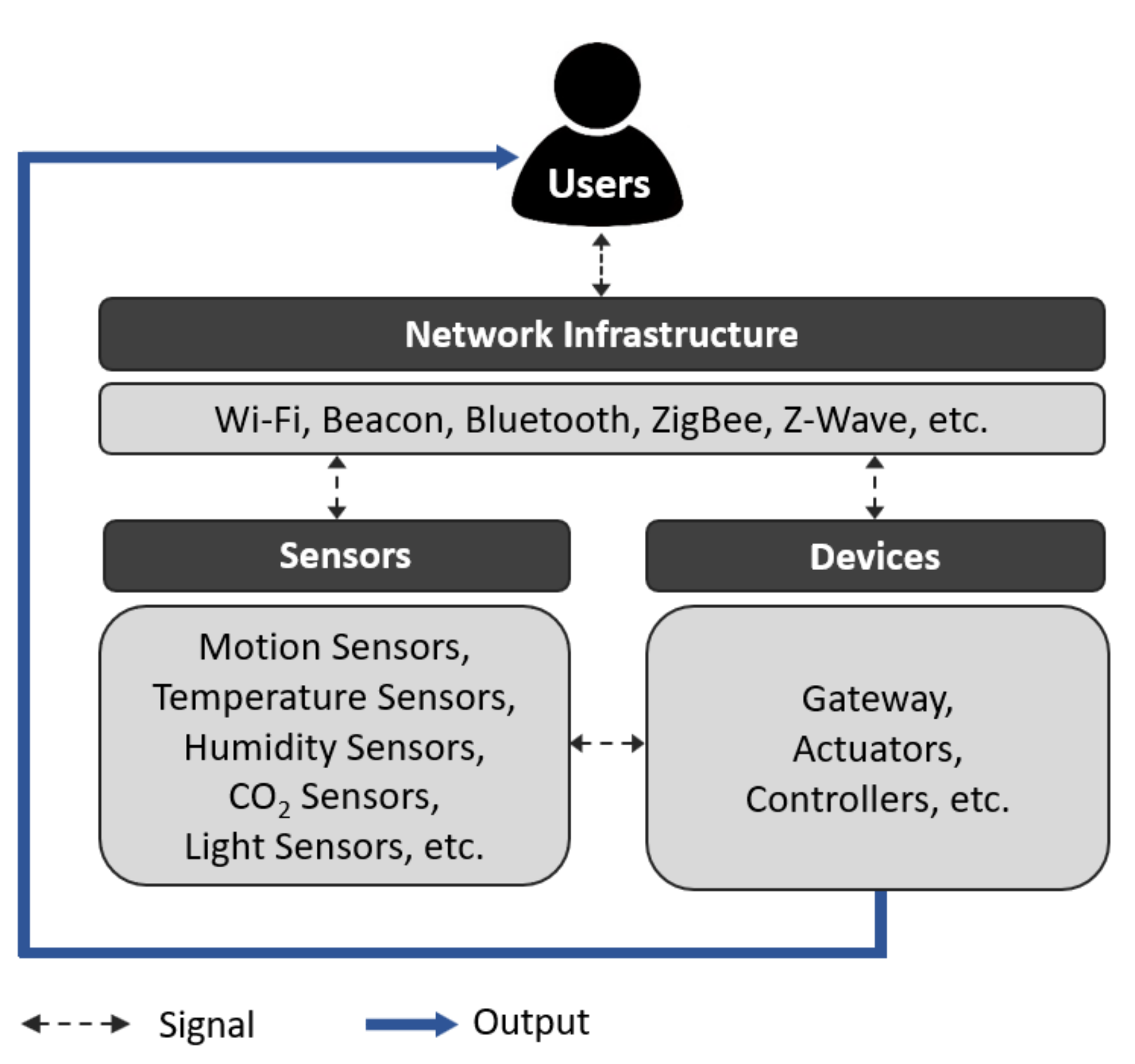
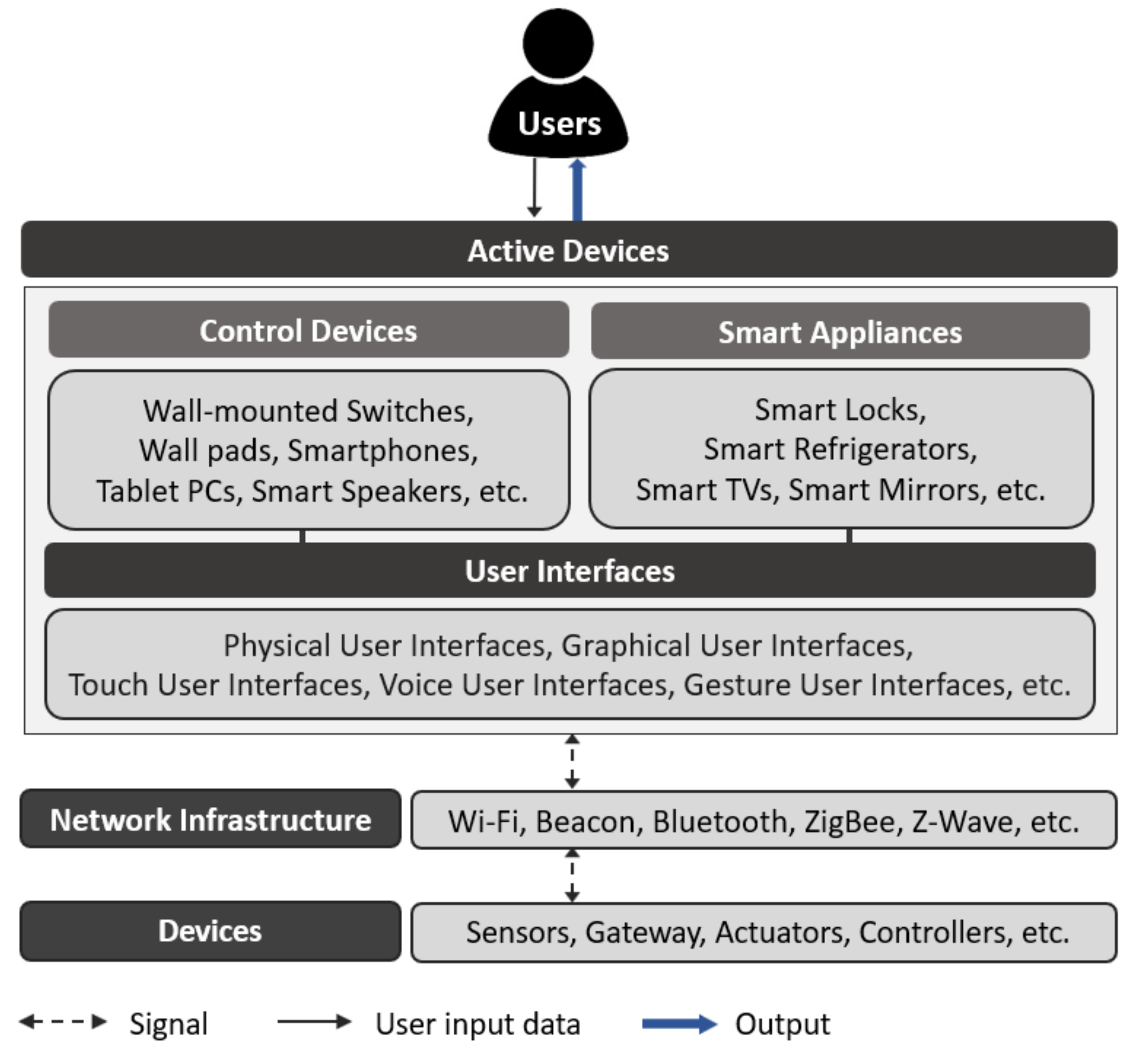
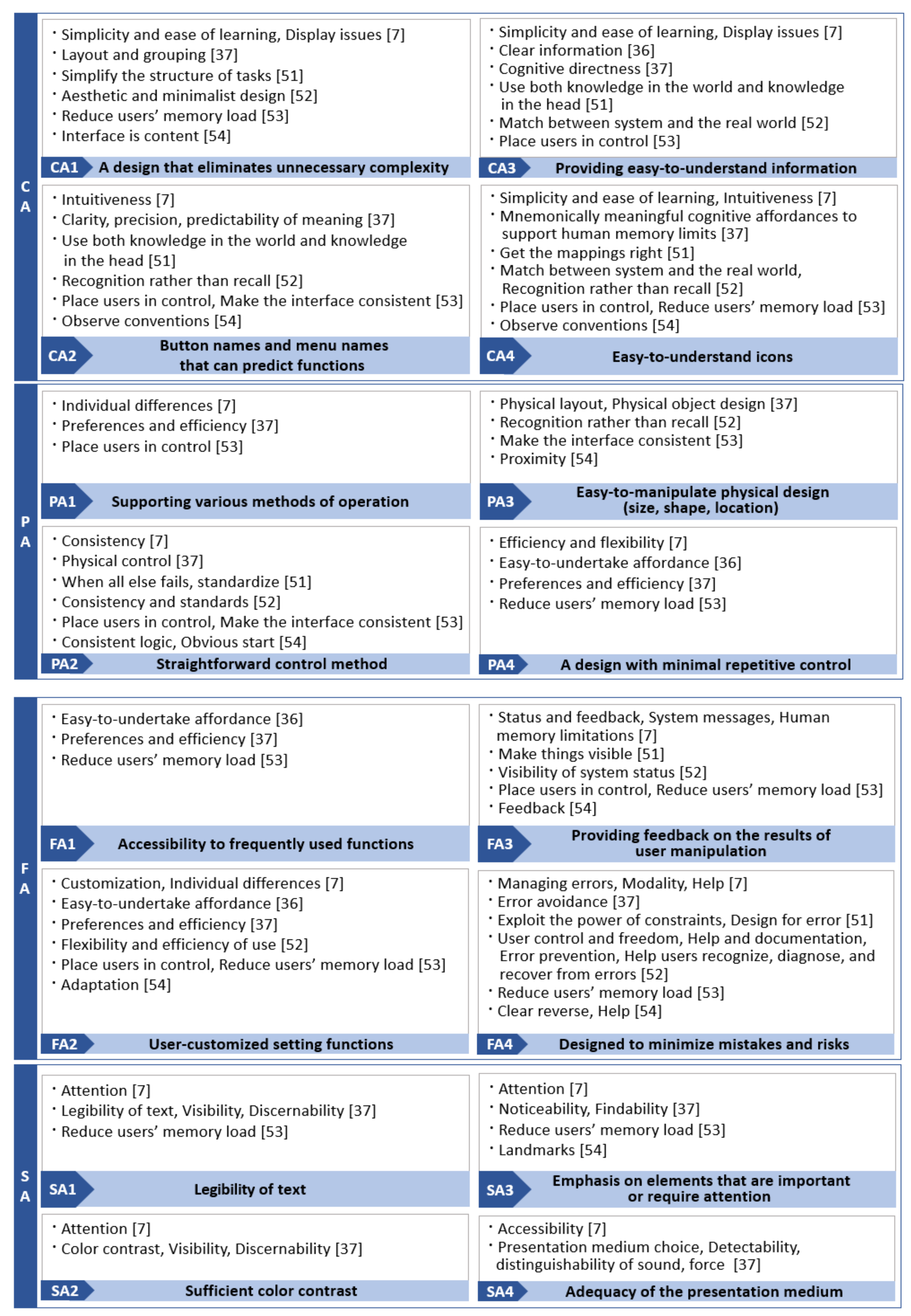
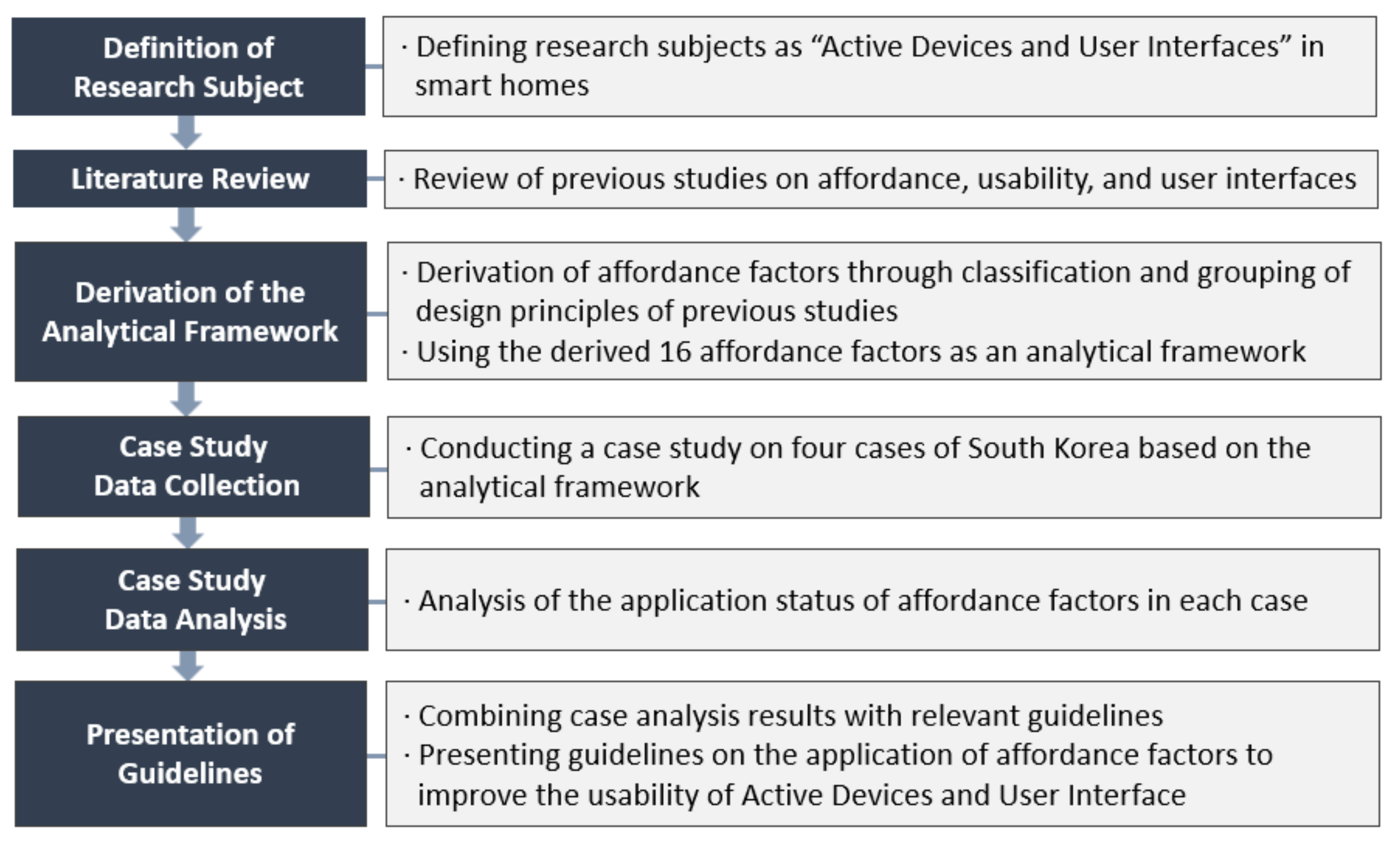



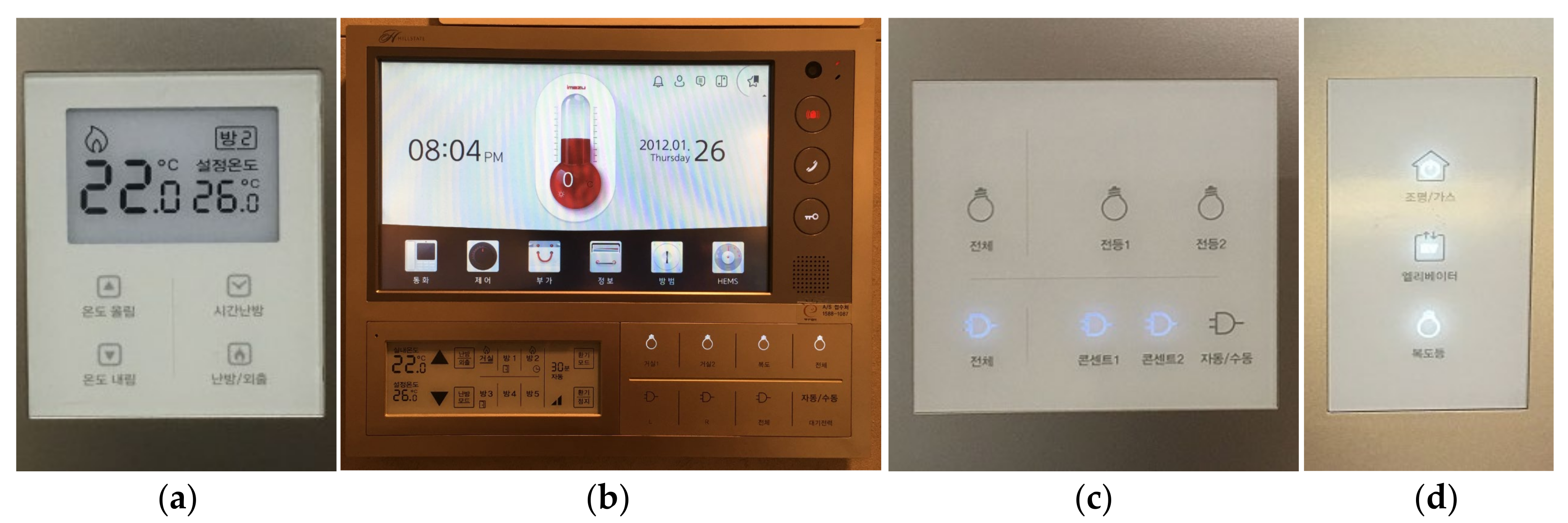
| Category | S Exhibition Hall | P Model House | L Model House | H Model House |
|---|---|---|---|---|
| Location | Jagok-dong, Gangnam-gu, Seoul | Daechi-dong, Gangnam-gu, Seoul | Dongcheon-dong, Gyeonggi-do, Yongin | Osan-dong, Gyeonggi-do, Hwaseong |
| Spatial configuration | Kitchen, living room, bedroom, dressing room, balcony | Entrance, living room, kitchen/dining room, bedroom, bathroom, powder room, balcony | Entrance, living room, kitchen/dining room, bedroom, bathroom, dressing room, balcony | Entrance, living room, kitchen/dining room, bedroom, bathroom, balcony |
| Image | 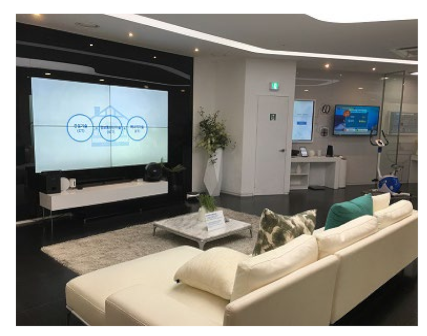 | 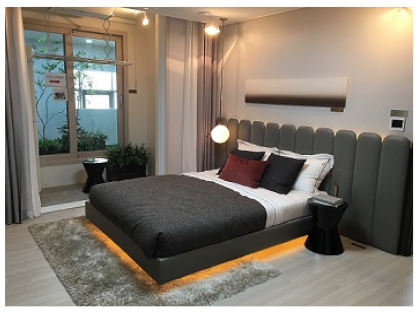 |  | 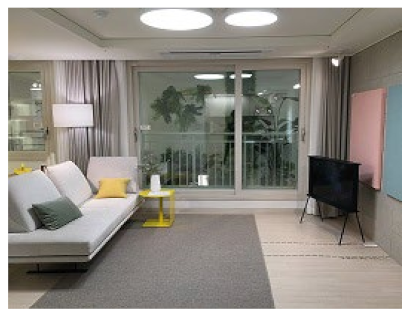 |
| Application Status of Affordance Factors | S | P | L | H | ||
|---|---|---|---|---|---|---|
| CA | CA1 | Simple appearance consisting of buttons of main functions | ✓ | ✓ | ✓ | ✓ |
| Grouping of related contents | ✓ | ✓ | ✓ | ✓ | ||
| CA2 | Button names and menu names using familiar terms | ✓ | ✓ | ✓ | ||
| Button names and menu names containing information about the function | ✓ | ✓ | ✓ | ✓ | ||
| CA3 | Use of familiar terms in providing information | ✓ | ✓ | ✓ | ✓ | |
| Key information provided concisely | ✓ | ✓ | ✓ | ✓ | ||
| CA4 | Use of familiar icons reminiscent of functions | ✓ | ✓ | ✓ | ✓ | |
| Use of icons with text labels | ✓ | ✓ | ✓ | ✓ | ||
| PA | PA1 | Indoor environment control using fixed and mobile devices | ✓ | ✓ | ✓ | ✓ |
| Application of multimodal interfaces | ✓ | ✓ | ✓ | |||
| PA2 | Control of devices via simple touch gesture | ✓ | ✓ | ✓ | ✓ | |
| Application of consistent operation method | ✓ | ✓ | ✓ | ✓ | ||
| PA3 | Touchscreen wall pad installation in the living room | ✓ | ✓ | ✓ | ✓ | |
| Wall mounted switch installation in each room | ✓ | ✓ | ✓ | |||
| Speakerphone installation in bathroom | ✓ | ✓ | ||||
| Appropriate button spacing for operation | ✓ | ✓ | ✓ | ✓ | ||
| Appropriate button size for operation | ✓ | ✓ | ✓ | ✓ | ||
| PA4 | Providing buttons to move to main menu on the wall pads | ✓ | ✓ | ✓ | ✓ | |
| Providing ‘All Off’ function on the wall pads or control switches | ✓ | ✓ | ✓ | |||
| FA | FA1 | Providing shortcut buttons on the wall pad for frequently used functions | ✓ | ✓ | ✓ | ✓ |
| Installation of switches for functions required when going out near the front door | ✓ | ✓ | ✓ | |||
| FA2 | Providing various mode setting functions | ✓ | ✓ | ✓ | ||
| Providing user’s preferred indoor environment setting function | ✓ | ✓ | ✓ | |||
| Providing personalized energy management service | ✓ | ✓ | ✓ | ✓ | ||
| FA3 | Providing immediate feedback on user’s action | ✓ | ✓ | ✓ | ✓ | |
| Providing multiple feedback | ✓ | ✓ | ✓ | ✓ | ||
| FA4 | Disabling a function that can cause risk | ✓ | ✓ | ✓ | ✓ | |
| Providing ‘Undo’ or ‘Cancel’ functions for the user’s action | ✓ | ✓ | ✓ | ✓ | ||
| Providing help | ✓ | ✓ | ||||
| SA | SA1 | Use of easy-to-read size text | ✓ | ✓ | ||
| Use of highly readable fonts | ✓ | ✓ | ✓ | ✓ | ||
| SA2 | Clear contrast between text color and background color | ✓ | ✓ | |||
| Clear contrast between button color and background color | ✓ | |||||
| SA3 | Emphasis on important functions or information using color | ✓ | ✓ | ✓ | ✓ | |
| Emphasis on important information by differentiating thickness or size of font | ✓ | ✓ | ✓ | ✓ | ||
| SA4 | Providing information using graphic elements | ✓ | ✓ | ✓ | ✓ | |
| Notification of situation using appropriate medium in case of danger | ✓ | ✓ | ✓ |
© 2020 by the authors. Licensee MDPI, Basel, Switzerland. This article is an open access article distributed under the terms and conditions of the Creative Commons Attribution (CC BY) license (http://creativecommons.org/licenses/by/4.0/).
Share and Cite
Cho, Y.; Choi, A. Application of Affordance Factors for User-Centered Smart Homes: A Case Study Approach. Sustainability 2020, 12, 3053. https://doi.org/10.3390/su12073053
Cho Y, Choi A. Application of Affordance Factors for User-Centered Smart Homes: A Case Study Approach. Sustainability. 2020; 12(7):3053. https://doi.org/10.3390/su12073053
Chicago/Turabian StyleCho, Younjoo, and Anseop Choi. 2020. "Application of Affordance Factors for User-Centered Smart Homes: A Case Study Approach" Sustainability 12, no. 7: 3053. https://doi.org/10.3390/su12073053
APA StyleCho, Y., & Choi, A. (2020). Application of Affordance Factors for User-Centered Smart Homes: A Case Study Approach. Sustainability, 12(7), 3053. https://doi.org/10.3390/su12073053




